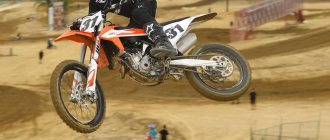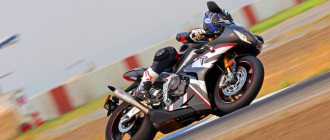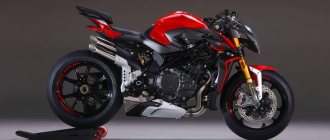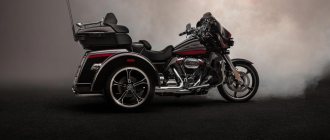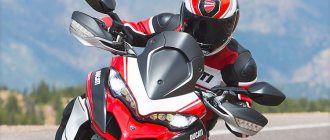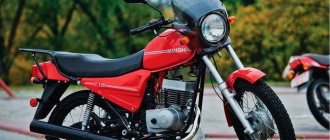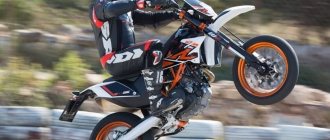Ducati Superleggera V4 2020
Just think: if a Ducati Superleggera V4 costs a hundred thousand bucks+, then the tax on it alone is more than what many sportbikes cost. Even new ones. Even the same cubic capacity.
And the price is not the only surprising number in the description of this exotic V4 R-based superbike: how about 234 horses and 158 kilograms? True, both of these figures require explanation.
Ducati Superleggera V4 2022
So, 234 horses become available using the Race Kit - a titanium Akrapovic racing exhaust and ECU flashing, and they were measured from the crankshaft - so this figure is not so important unless you plan to put the 998 cc Desmosedici Stradale R engine in some direct drive device. When it's parked in the bike, the power flows through the transmission (and the idler shaft, since the V4 crank spins in the opposite direction) and then through the final drive. Usually all this eats up about 10%, but even minus 24 horses, the Superleggera produces more than two hundred from the wheel at 15,250 rpm.
158 kilograms is the dry weight of the Ducati Superleggera V4 2020 : no gasoline, no antifreeze, no oil, not even brake fluid. Why does Ducati weigh a motorcycle that cannot be ridden when classmates publish the curb weight? Then why do you stretch out and pull in your stomach in general photographs - to look better? With all fluids, the Superleggera weighs about 181 kilos - the same as the Yamaha MT-07, one of the smallest and nimble naked bikes.
In general, even the real numbers of the Superleggera V4 make it stand out from the rest. This is the lightest, most powerful and most complex Ducati motorcycle. And one more number: 500. This is how many copies of the Superleggera V4 will be produced.
Such an exclusive motorcycle raises a lot of questions. I'm lucky: having spoken with Ducati and ridden a pre-production Superleggera, I can answer some of them.
Ducati Superleggera V4 2020
Why Ducati Superleggera V4?
Small-scale production is a Ducati tradition that dates back to the 888SPS from the late nineties. Many models (including the V4 R on which the Superleggera is based) are designed to be homologated for the track - including competitions in which production models compete. And the lower limit of the series is just 500 units per year, so the most modified devices can participate in competitions like World Superbike.
Some other low-production models were made as tributes, and some were simply made as a manifesto of Ducati's passion for innovation and powerful motorcycles. In particular, this is the case with the Superleggera V4.
Ducati says the Ducati Superleggera V4 serves the main purpose of demonstrating what its manufacturer is capable of. This is an opportunity to give 200%, set a new benchmark for engineers from Bologna, and push the development of technical solutions and processes that lie at the heart of the company's know-how. This includes new techniques for working with carbon fiber, developments in aerodynamics and computer modeling of hydrodynamic processes, and many other high-tech aspects.
And it is this kind of dedication and fervor that wins the hearts of fans around the world, sometimes even forcing them to get tattoos of Ducati L-twins. It's motorcycles like this that make Ducati what it is.
Of course, there will be those who will criticize the Ducati Superleggera V4 as a marketing ploy with an overly inflated price tag. But even if there is 5% truth in these words, it is difficult to deny that the remaining 95% of the truth is not about price, but about innovation and demonstration of capabilities.
What's special about the Ducati Superleggera V4?
Superleggera means “super light” in Italian, a term and approach Ducati already applied to the 1199 Panigale in 2014.
The recipe for a super-light superbike is heavily mixed with exotic materials such as titanium and carbon, due to which the weight is significantly reduced. So this motorcycle is unusual in a technical sense because of its low weight and extreme methods of achieving it. Of course, this also includes the highest engine performance and the latest technology in the world of top superbikes.
The current Superleggera is based on the V4 R, a 998 cc special edition introduced in 2022. Ducati then used wagons of carbon fiber and sawed wagons of aluminum and titanium filings to remove 16 kilograms of excess weight from the V4 R. That's quite a lot, considering that the V4 R is already almost 7 kilos lighter than the standard 1103 cc Panigale V4.
Literally everything on the Ducati Superleggera V4 is made of carbon. The front part of the frame, the subframe, the swingarm - it's all made of carbon composite, and when you hold these components in your hands, it's hard to believe that there is anything so elegant, light and at the same time strong, capable of withstanding the power of such an engine. The chassis in this form is lighter than the aluminum version of the V4 R by a little over 3 kilos.
Then - carbon wheels and body kit, titanium sprocket and axle nuts, shock absorber spring. Yes, the spring on the rear Ohlins TTX36 is made of a titanium alloy with a completely different spring rate than steel, which required a complete re-tuning of the smoothing. The NPX25/30 gas fork has lightweight milled bottoms. Milled footrests, cross bars and many other elements also make a small contribution to weight reduction. Even the pistons in the new Brembo Stylema R calipers are drilled, as are the camshaft cams in the desmodromic drive, as is the gearshift drum in the gearbox.
The engine, which was already equipped with magnesium covers and titanium connecting rods and intake valves, is equipped with titanium and aluminum hardware in the Superleggera V4 R. The Euro4-compliant Akrapovič exhaust saves another 2 kilos, but upgrading to the full Akrapovič racing exhaust that comes standard with every Superleggera saves another 3-plus kilos and unlocks an additional 25 horses.
EICMA-2016: Ducati Panigale 1299 Superleggera (Project 1408) - 220 hp. at 162 kg
At the official presentation in Milan, KayCasey Stoner presented the unique Ducati Projetto 1408 hyperbike - the Ducati Panigale 1299 Superleggera, which is the most powerful production motorcycle with a 2-cylinder engine in history: official data - with 162 kg of dry weight, the engine should produce up to 220 hp.
MOTOGONKI.RU, November 7, 2016 — Rumors just spread across the Internet that Ducati Corse had some disagreements with Stoner, and he’s right there! The Australian came to Milan to take part in one of the most important premieres of EICMA-2016.
Full photo gallery: Ducati PANIGALE 1299 SUPERLEGGERA (2017) - details
Casey Stoner rolled out the main new Ducati Panigale 1299 Superleggera - Projetto 1408 - onto the stage of the National Theater of Milan
In 2014, at EICMA 2014, Domenicali presented the first version of the Superleggera (i.e., super-light version) Panigale 1199 R, then it was perceived as a fetish. Bikeporn fans have a blast: the rolling chassie, freed from plastic, is available to photographers and tech geeks on the stage of the National Theater of Milan. Here it is, in an exclusive photo gallery on MOTOGONKI.RU (click the photo to go to the selection):
Ducati 1199 Panigale Superleggera – bike porno go to photo gallery
But the Ducati Projetto 1408 based on the Panigale 1299 R is not just a fetish, but a technological bomb on the performance motorcycle market. Kawasaki is flexing its muscles, presenting variations on the theme of the turbocharged H2R, and Ducati - the main competitor of the Japanese in World Superbike, and indeed in the hyperbike market today - produces something not even from the world of MotoGP, but from some new, hitherto unknown world.
So, what has become known about the Projetto 1408? Uprated L-Twin engine of the Testastretta 11° family with a volume of 1285 cc. equipped with new, lightweight “racing” pistons with a diameter of 116 mm with 2 oil scraper rings. The power system has been optimized, and the throttle valves now have a special (read carefully) aerodynamic shape, which reduces the flow resistance when the mixture enters the cylinders. Thanks to a series of optimizations in the basic version for European countries, even taking into account the new Euro 4 environmental standards, the engine should produce 215 hp. power at 11000 rpm. and 146.2 Nm of torque at 9000 rpm.
EICMA-2016: Ducati Panigale 1299 Superleggera (2017): Acrapovic titanium exhaust system from racing kit go to photo gallery
The motorcycle will be available in three modifications: base for the US market - 165 kg, base for the European market - 167 kg and racing - 162 kg. The basic version is equipped with an exhaust system with a catalyst located under the engine, like the basic version of the 1299 Panigale.
Power curve of the Testastretta 11 Ducati 1299 Superleggera engine as standard
Particular attention to the last point: we are talking about a motorcycle with an additional racing kit installed. The kit includes a set of Acrapovic titanium sports pipes and end stops. With the installation of the kit, the power increases to 220 hp, that is, the power-to-weight ratio becomes 1.36 hp/kg. The measurements, however, are exclusively on the crankshaft! Our American colleagues will probably soon tell you how much it ultimately reaches the rear wheel.
The carbon monocoque frame element weighs 2.6 kg - this is 1.7 kg or immediately 40% lighter than an aluminum one go to photo gallery
The motorcycle is built on the same principle as the Panigale 1299, and the plant has gone even further in lightening than in 2014. The engine is the main power element of the chassis and is connected to the fork via a full carbon monocoque element, as in the 2007 Desmosedici prototype.
Ducati Panigale 1299 Superleggera rear wheel swingarm made of carbon with aluminum bushings go to photo gallery
The ultra-light subframe (only 900g) and rear wheel console are made of carbon and reinforced with aluminum parts from the 7075 alloy used by Ducati Corse in MotoGP. The carbon monocoque frame element weighs 2.6 kg - this is 1.7 kg or 40% lighter than the aluminum (4.3 kg) that is used in the basic configuration of the 1299 Panigale!
EICMA-2016: Ducati Panigale 1299 Superleggera (2017) - super-light carbon wheels with an aluminum hub - allowed to reduce the weight of the motorcycle by 2.8 kg. go to photo gallery
The wheels are also made of carbon fiber, only the hubs are made of milled aluminum. Only this made it possible to reduce inertia at the front-end by 26% and at the rear-end by 58%, and the total mass of the elements by 2.8 kg. For additional lightness, the plant uses a Li-Ion battery in the design, which weighs only 200 g.
EICMA-2016: Ducati Panigale 1299 Superleggera (2017) - engineering as an art go to photo gallery
The chassis is built with components like a factory superbike in World Superbike or better (as no FIM material approval is required).
EICMA-2016: Ducati Panigale 1299 Superleggera (2017) is equipped with an ultra-light Ohlins FL936 fork with lightweight brake mounts go to photo gallery
A fork with lightweight Ohlins FL939 stays and a lightweight mounting bracket, as well as an Ohlins TTX36 rear shock absorber with a titanium spring, is another minus 1.2 kg. The Brembo MCS master cylinder drives Brembo M50 radial calipers equipped with pads with a special compound.
The Project 1408 chassis and electronics are something that Ducati never wants to hide from view under plastic go to photo gallery
Against the background of total carbonization (the most expensive chemical element in this design), the presence of the most complete set of control electronics is like a free bonus. The motorcycle is equipped as standard with the evolutionary Ducati Traction Control Evo, Ducati Wheelie Control Evo, Advanced Slide Control, Launch Control and Cornering ABS. All components are connected to a network based on the Bosch inertial system, the control panel is equipped with its own data logger with GPS.
Full photo gallery: Ducati PANIGALE 1299 SUPERLEGGERA (2017) - details
Since the piece is exclusive, only 500 copies will be produced, and the price will reach 80,000 euros. Pre-order is open now on the website, which... has been there since the moment the presentation began - are there already so many people interested?
What else makes the Ducati Superleggera V4 special?
Large double wings on the sides of the muzzle. Like the carbon structural components, like the engine of the Desmosedici Stradale R, the wings of the Superleggera V4 are part of Ducati's journey to push the boundaries. You may think that we are talking about the boundaries of good taste, but in fact the wings not only give a specific appearance, but also stabilize, create considerable downforce , allowing you to go faster, and Ducati assure that their design is more efficient than aerodynamics of last year's MotoGP bike.
Ducati Superleggera V4 fenders
More features? Each copy is signed. The key and the upper yoke are marked with a serial number (one of 500), and a nameplate is attached to the cylinder head with the name of the technician who set the clearances of the desmodromic valves. Superleggera buyers will also get the opportunity to fly to Europe and ride the WSBK machine, and 30 of them will be able to buy some time in the saddle of a real MotoGP machine.
Some would say that owning a Ducati is a constant waste of money, but it would be more accurate to say that owning a Ducati is a constant learning experience, and the opportunities offered by the company from Bologna are not so easy to obtain in any other way.
How does the Ducati Superleggera V4 ride?
What does the pilot of a 234-horsepower motorcycle for one hundred thousand bucks feel? Anxiety. Fear. Delight. Fear. These are just a few of the many words that can describe the range of feelings that possessed me while I was driving. And I was just driving to the track, not on the track!
At the track, Ducati gave us the standard 209 horsepower V4 R to warm up. It's a superb machine, no doubt, I've ridden one before and I'd say it's one of the smoothest revving engines around. Power builds like pressure in a steam boiler, and it pulls harshly right up to the 15,500 rpm cutoff. It’s hard to believe that according to regulations, valve clearances are adjusted every 24 thousand kilometers, and the factory warranty for this locomotive is 2 years without mileage restrictions.
The twin flashes of the 90-degree V-four group the cylinders in twos: one left, one right, pause, then another left and another right. Doesn't remind you of anything? Yes, of course, order, character, V-twin thrust. The sound is reminiscent of a short-throw Panigale V-twin, but with a slight offset, much like how a slight echo is applied to vocals in a recording studio to give the voice depth and volume. It's a unique and very enticing sound.
Six laps on the Ducati Superleggera V4 to explore the track and it was time for the first of my two 15-minute sessions on the SL. Akrapovič immediately makes itself felt: if on the R you can still hear the characteristic “bucket of bolts” of the dry clutch, then on the SL this sound is drowned in the roar of a racing pipe. The uninitiated would call it stunning, but I prefer the epithet “juicy.”
Ducati Superleggera V4 on the track
Honestly, my riding skill allows me to barely touch what a regular V4 R (forgive me the word “regular”) can do. But even so, the Superleggera feels different compared to it. I didn't notice any difference in power - it would be as easy as feeling the biggest hailstones during a hail storm - and I opened the throttle wide open in just a couple of places on the track, but the Ducati Superleggera V4 is actually easier to ride. The weight savings are quite obvious, especially noticeable under braking, where the ultra-light SL decelerates noticeably faster and requires less effort to control when braking in corners.
But the main difference with the Ducati Superleggera V4 is perhaps its high-speed stability and cornering feel. Where on the V4 R, even with its wings, the front part rises and begins to fidget, and the motorcycle dances and prances, the Ducati Superleggera goes clearly and tenaciously, inciting you to add gas (and the speedometer shows 240), or at least not to close on a long arc. I attribute this to the large twin wings, which add almost 50 kilograms of downforce to the front end at this speed, pressing the nose to the track. And even though they look like moth antennae, they work. After all, moths do understand something about wings.
But it's not just about quick straights. It’s strange that the Superleggera V4 requires a little more effort to turn into corners, but it stays in them more strictly, keeping its trajectory clearly. It doesn’t just feel glued, it’s as if something is holding it from the outside. I think partly it’s again aerodynamics (and this explains the effort in turning), and partly, I’d like to think, it’s the different properties of the carbon chassis. Ducati says it has taken advantage of the carbon composite when designing the frame's flex characteristics, a key factor in traction and rider feedback.
Another interesting aspect of the chassis is that under heavy braking you hardly feel the rear lifting up until, of course, you lean into a corner, where the rear wiggles gracefully. The same applies to power slides (of which, by the way, there were very few due to the excellent grip of the Pirelli slicks installed instead of the standard road Diablo Supercorsa SP). It all happens somehow imperceptibly - probably I’m just not accustomed to feeling the feedback from the rear wheel through the carbon chassis.
It would be great to focus on these sensations and study them in more detail to get a better feel for the bike, but at each apex you open up and that's where the Superleggera takes all your attention.
Ducati Superleggera V4 2020
The acceleration is amazing, but despite the crazy traction, I almost didn’t notice that he was trying to get into the candle. Perhaps I was just careful with the throttle, but the 16mm longer swingarm certainly helps, as does the downforce of the wings, which, of course, is proportional to speed. In any case, I'm glad that there are few distractions from driving...
Because the Superleggera is a beast.
A little too much gas or a quarter of a second of delay with braking - and the result will not be long in coming: you slow down significantly. This device requires a jeweler's ride, but it responds to the rider's actions with pinpoint precision, regardless of speed, incline or track section. It's refined, responsive and predictable - and inspires far more confidence than terror. It's really easy to ride, and if you have the skills, it can go fast.
In general, I don’t have much, but at least I have time to figure out what I’m doing - I’m riding the latest, most expensive and most magnificent Ducati superbike. And when I saw the checkered flag, which meant the imminent end of my race, I drove the last lap slowly, in order to realize and feel with my mind everything that I did on emotions and reflexes, to feel the engine, the clarity of the quickshifter, the view from behind the milled upper yoke. I won't soon forget this ride.
Motorcycle Ducati 1199 SuperLeggera 2014 review
Description of the Ducati 1199 SuperLeggera 2014 motorcycle is in the queue for publication of the article. Announcement: Today, for almost every new motorcycle that comes into being, marketers strive to carve out their own niche. This one is a road sport, this one is a recreational enduro. But what class should we include a motorcycle that has a little bit of everything? A good bike should have a reliable engine, comfortable ergonomics and simple controls...
Ducati 1199 SuperLeggera is a motorcycle not sold in Russia, equipped with a very high power 200 hp engine. Despite the fact that good models of motorcycles have a very respectable price, and the season for their use is relatively short, the motorcycle market is developing rapidly. And if you believe the words of dealers, then some models of recently released motorcycles are selling like hot cakes at the beginning of the season, and the models brought to Russia are clearly not enough to fully satisfy consumer demand.
A motorcycle has long ceased to be an alternative to a car, and the times when this equipment was bought only because there was not enough money for a full-fledged car are forgotten. Nowadays, two-wheelers can be called technological marvels in many cases, and their cost can be compared with that of prestigious cars.
Many people have started buying motorcycles for hobby purposes as riding or even collecting them has become a good pastime for many people. Many motorcycles, for example the Ducati 1199 SuperLeggera, whose technical characteristics make it possible to call the model a prestigious brand, are in demand among both beginners and experienced motorcyclists.
Motorcycles with an engine capacity of 1199 cc. see, appeared as a result of long work of inventors who sought to create a model that was not inferior in characteristics to other versions of the motorcycle. In some cases, these models are not only not inferior, but also ahead of other motorcycles, as they have minimal fuel consumption and other excellent parameters.
Motorcycles with an engine capacity of more than 400 kb. cm, which includes the Ducati 1199 SuperLeggera - this category of motorcycles simply cannot claim the title of “motorcycle for a beginner.” On the contrary, this is already a serious technique that requires certain control of motorcycle equipment with a smaller engine capacity. Yes, she attracts more attention, she is the most beautiful, fast, interesting and there is a huge selection of models. But as power increases, the weight of the motorcycle inevitably increases. In this class you are unlikely to find motorcycles lighter than 180 kg, unless they are the latest motorcycle models.
Go to the entire range of Ducati motorcycles, on this page you can find Ducati 1199 SuperLeggera motorcycles from other years and information about them
It's cool, but why is it so expensive?
The V4 R, the basis of the Superleggera, costs $40,000. And the Ducati Superleggera V4 is 60 thousand more expensive. Quite a difference.
I didn't discuss it with the Ducati rank and file, but in a brief conversation with one of the managers of the local representative office, I learned that the issue is not only the cost of materials, but also the costs of the production line and the cost of development, which are distributed over 500 copies.
Cost also plays a role - the Ducati Superleggera V4 literally consists of expensive materials and high-tech processes, specialized and very expensive. Many powerful motorcycles are made from cast aluminum components - frames, wheels - and these technical processes are ready and debugged. Roughly speaking, any country, even the most seedy, has its own casting production, which became known long before our era. The Superleggera's chassis is made from material dating back to 1963, and the carbon components are meticulously inspected for any imperfections, as only solid, flawless composite elements are capable of withstanding the tasks assigned to them. Carbon assemblies are studied both with an ultrasonic flaw detector and with X-rays, and this alone requires high-quality equipment and qualified specialists - this is not a search for cracks and lack of fusion.
Ducati Superleggera V4 2020
Also, the low weight of the Superleggera requires a complete recalibration of not only the suspensions, but also the entire set of electronic assistants, track rental, and the salaries of programmers are very significant. And then the wind tunnel begins, then the publication costs, and finally the press ride followed by a buffet...
Ducati begins its 95th year of history: from radio to Superleggera V4
Ducati was founded on July 4, 1926, as a designer and manufacturer of radios, and today it is one of the key links in the Volkswagen-AUDI Group (VAG) - one of its most valuable assets.
MOTOGONKI.RU, July 5, 2022 — Over the 94 years of its existence, Ducati has experienced a number of grandiose reformations.
The Società Scientifica Radio Brevetti Ducati factory for the production of radio tubes and other components for radio equipment was founded by Antonio Cavalieri Ducati and his sons Adriano, Marcello and Bruno. Driven by growing demand for consumer, scientific and professional equipment, the Ducati company grew rapidly, so that already in 1935 it acquired its own building with a full-fledged production in the center of Borgo Panigale, where it is located to this day.
First stone of the Antonio Cavalieri Ducati factory in Borgo Panigale
At the exhibition “Ducati Style” at the Erarta exhibition complex in St. Petersburg, in the spring-summer of 2022, visitors could see with their own eyes one of Antonio Cavalieri’s Ducati products - a luxurious broadband radio, as well as 16 motorcycles that characterize the company, its technology and style.
The path of Ducati's creation and development as a motorcycle company is in many ways similar to Honda's. Both companies began business in a different area, which was radically changed by World War II.
Cavallieri radio at the Ducati Style exhibition
But unlike many German and Japanese enterprises, either devastated by the war or forced to repurpose, Ducati continued to operate from 1939 to 1944. The plant in Borgo Panigale several times became a target for Allied bombers, in particular, American aviation: after all, Mussolini collaborated with Hitler , and Italian industry worked for Germany.
Ducati began thinking about the possibility of producing a different type of product after the liberation of Italy from the Nazis. In collaboration with the Turin-based SIATA, which had developed an affordable bicycle engine, Antonio Cavalieri's company began producing the motorized bicycle "Cucciolo" (or "puppy", so called for its characteristic exhaust sound).
The first motorcycle Ducati Cucciolo (1950)
By 1950, Ducati and SIATA had jointly produced and sold more than 200,000 Cucciolos. Antonio Cavalieri, being a good businessman, decided to launch a motorcycle of his own production into series. The first Ducati motorcycle was equipped with a 48 cc engine and could accelerate to 64 km/h, consuming approximately 1.2 l/100 km. The alien name "Cucciolo" was soon abandoned in favor of its own "55M".
In the 50s, the market began to demand increased engine sizes, speeds and overall performance from cars and motorcycles, and Cavalieri decided to enter the fight for a piece of the pie. Ducati has produced large motorcycles with 4-stroke engines of its own production.
The first Ducati 60 motorcycle
The first production Ducati motorcycle was another one - the Ducati 60, designed by designer Gian-Luigi Capellino, who created several more historical masterpieces over many years of cooperation with the plant. The motorcycle was equipped with a 2-horsepower 59 cc engine that accelerated the bike to 60 km/h, but it was already a real motorcycle - with good brakes and a powerful backbone frame, which could carry two people.
Ducati Meccanica SPA
In 1953 the company was divided into two independent brands - Ducati Meccanica SpA and Ducati Elettronica. The mechanical plant remained in Borgo Panigale and received government support, thanks to which production was modernized. A year later he could already produce up to 120 motorcycles daily.
Ducati 175 T is the first full-fledged cruiser with a 4-stroke engine in the Ducati line-up
In the 60s and 70s, the motorcycle industry was developing rapidly on both sides of the Atlantic, but also in Britain, and the Italians were forced to respond to the challenges by developing ever more advanced and faster engines. The history of the Ducati V-twin with desmodromic valve actuation began in 1973.
Exhibition Ducati Style in St. Petersburg
Ducati has been the subject of auctions several times. So, in 1985, the plant in Borgo Panigale was completely purchased by Cagiva, which intended to produce motorcycles there under its own name. But thanks to investments from TPG (one of the largest investment companies of the 90s - Texas Pacific Group), the Ducati brand was saved, and by 1999 the plant was restored to independence.
Casey Stoner, 2007 MotoGP champion with Ducati
In 2003, Ducati entered MotoGP with its own 990 cc Desmosedici prototype (D16 - "Desmodromic 16-valve"), which was successful from the very first races, and factory driver Loris Capirossi began finishing on the podium. In 2007, with the arrival of Casey Stoner at Ducati Corse and the transition to 800 cc engines, something that no one expected happened - Stoner on the D16 GP07 brought the plant two titles at once - in the individual competition and the Manufacturers' Cup. Then, Yamaha and Honda mobilized their forces, and Stoner began to experience health problems, so it was not possible to keep the crown in his hands.
Ducati Superleggera V4
After the global financial crisis of 2008-2010, Ducati again began to experience financial problems, and as a result of a year of searching for a new partner, the company was bought by VAG. The €860 million deal took place in January 2012 and was approved by the EU in April. VAG helped Ducati not only with finances, but also with technology. Today, Ducati is one of the 6 selected global motorcycle manufacturers that represent their colors in the MotoGP and World Superbike World Championships. Since 2017, Ducati has been competing for the MotoGP title alongside Honda and Yamaha.
Ducati Museum in Borgo Panigale
In honor of its birthday, the factory has reopened the official Museo Ducati in Borgo Panigale to the public: a visit is a must for all fans of the brand and owners. If you can’t get to Bologna, a virtual tour of the Ducati Museum will help you!

